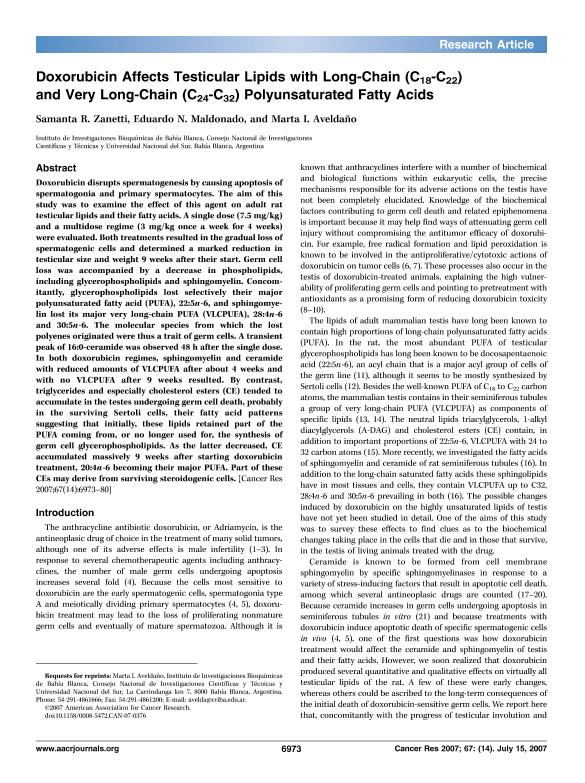Mostrar el registro sencillo del ítem
dc.contributor.author
Zanetti, Samanta Romina

dc.contributor.author
Maldonado, Eduardo N.
dc.contributor.author
Aveldaño, Marta Isabel

dc.date.available
2018-05-09T20:48:06Z
dc.date.issued
2007-07
dc.identifier.citation
Zanetti, Samanta Romina; Maldonado, Eduardo N.; Aveldaño, Marta Isabel; Doxorubicin Affects Testicular Lipids with Long-Chain (C18-C22) and Very Long-Chain (C24-C32) Polyunsaturated Fatty Acids; American Association for Cancer Research; Cancer Research; 67; 14; 7-2007; 6973-6980
dc.identifier.issn
0008-5472
dc.identifier.uri
http://hdl.handle.net/11336/44698
dc.description.abstract
Doxorubicin disrupts spermatogenesis by causing apoptosis of spermatogonia and primary spermatocytes. The aim of this study was to examine the effect of this agent on adult rat testicular lipids and their fatty acids. A single dose (7.5 mg/kg) and a multidose regime (3 mg/kg once a week for 4 weeks) were evaluated. Both treatments resulted in the gradual loss of spermatogenic cells and determined a marked reduction in testicular size and weight 9 weeks after their start. Germ cell loss was accompanied by a decrease in phospholipids, including glycerophospholipids and sphingomyelin. Concomitantly, glycerophospholipids lost selectively their major polyunsaturated fatty acid (PUFA), 22:5n-6, and sphingomyelin lost its major very long-chain PUFA (VLCPUFA), 28:4n-6 and 30:5n-6. The molecular species from which the lost polyenes originated were thus a trait of germ cells. A transient peak of 16:0-ceramide was observed 48 h after the single dose. In both doxorubicin regimes, sphingomyelin and ceramide with reduced amounts of VLCPUFA after about 4 weeks and with no VLCPUFA after 9 weeks resulted. By contrast, triglycerides and especially cholesterol esters (CE) tended to accumulate in the testes undergoing germ cell death, probably in the surviving Sertoli cells, their fatty acid patterns suggesting that initially, these lipids retained part of the PUFA coming from, or no longer used for, the synthesis of germ cell glycerophospholipids. As the latter decreased, CE accumulated massively 9 weeks after starting doxorubicin treatment, 20:4n-6 becoming their major PUFA. Part of these CEs may derive from surviving steroidogenic cells.
dc.format
application/pdf
dc.language.iso
eng
dc.publisher
American Association for Cancer Research

dc.rights
info:eu-repo/semantics/openAccess
dc.rights.uri
https://creativecommons.org/licenses/by-nc-sa/2.5/ar/
dc.subject
Antineoplasic Drugs
dc.subject
Spermatogonia
dc.subject
Apoptosis
dc.subject
Testicular Lipids
dc.subject.classification
Otras Ciencias Biológicas

dc.subject.classification
Ciencias Biológicas

dc.subject.classification
CIENCIAS NATURALES Y EXACTAS

dc.title
Doxorubicin Affects Testicular Lipids with Long-Chain (C18-C22) and Very Long-Chain (C24-C32) Polyunsaturated Fatty Acids
dc.type
info:eu-repo/semantics/article
dc.type
info:ar-repo/semantics/artículo
dc.type
info:eu-repo/semantics/publishedVersion
dc.date.updated
2018-04-18T15:09:44Z
dc.journal.volume
67
dc.journal.number
14
dc.journal.pagination
6973-6980
dc.journal.pais
Estados Unidos

dc.journal.ciudad
Filadelfia
dc.description.fil
Fil: Zanetti, Samanta Romina. Consejo Nacional de Investigaciones Científicas y Técnicas. Centro Científico Tecnológico Conicet - Bahía Blanca. Instituto de Investigaciones Bioquímicas de Bahía Blanca. Universidad Nacional del Sur. Instituto de Investigaciones Bioquímicas de Bahía Blanca; Argentina
dc.description.fil
Fil: Maldonado, Eduardo N.. Consejo Nacional de Investigaciones Científicas y Técnicas. Centro Científico Tecnológico Conicet - Bahía Blanca. Instituto de Investigaciones Bioquímicas de Bahía Blanca. Universidad Nacional del Sur. Instituto de Investigaciones Bioquímicas de Bahía Blanca; Argentina
dc.description.fil
Fil: Aveldaño, Marta Isabel. Consejo Nacional de Investigaciones Científicas y Técnicas. Centro Científico Tecnológico Conicet - Bahía Blanca. Instituto de Investigaciones Bioquímicas de Bahía Blanca. Universidad Nacional del Sur. Instituto de Investigaciones Bioquímicas de Bahía Blanca; Argentina
dc.journal.title
Cancer Research

dc.relation.alternativeid
info:eu-repo/semantics/altIdentifier/url/http://cancerres.aacrjournals.org/content/67/14/6973
dc.relation.alternativeid
info:eu-repo/semantics/altIdentifier/doi/http://dx.doi.org/10.1158/0008-5472.CAN-07-0376
Archivos asociados
